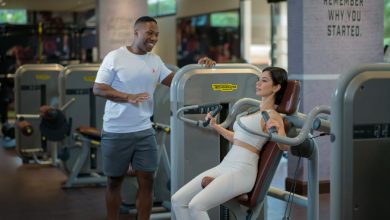Empowering Fitness at Home: A Comprehensive Guide to Home Workout Programs

Introduction:
In the fast-paced modern world, maintaining a healthy lifestyle can be challenging, especially with busy schedules and various commitments. However, the rise of home workout programs has revolutionized the fitness landscape, offering individuals the flexibility, convenience, and accessibility to achieve their fitness goals from the comfort of their own homes. These programs provide structured exercise routines, expert guidance, and motivational support, catering to a diverse range of preferences, fitness levels, and lifestyles. In this comprehensive guide, we’ll delve into the benefits of home workout programs, explore key components and considerations, and provide practical tips for starting and sticking to a successful home fitness routine.
Benefits of Home Workout Programs:
Convenience:
Home workout programs eliminate the need for commuting to the gym, saving time and energy. Individuals can exercise whenever it fits into their schedules, whether it’s early morning, during lunch breaks, or in the evening.
Accessibility:
Home workout programs are accessible to everyone, regardless of fitness level, age, or location. They provide a welcoming environment for beginners and offer advanced options for seasoned fitness enthusiasts.
Cost-Effectiveness:
Compared to gym memberships and personal training sessions, home workout programs are often more affordable. There are minimal upfront costs, and many programs require little to no equipment, making them budget-friendly.
Privacy and Comfort:
Exercising at home offers privacy and comfort, allowing individuals to focus on their workouts without feeling self-conscious. There’s no need to worry about crowded gyms, waiting for equipment, or feeling judged by others.
Customization:
Home workout programs offer flexibility and customization, allowing individuals to tailor their workouts to their specific goals, preferences, and fitness levels. With a wide variety of programs available, there’s something for everyone, whether you prefer strength training, cardio, yoga, or dance workouts.
Consistency:
Consistency is key to seeing results from any fitness program, and home workouts make it easier to stay on track. With no travel time or scheduling conflicts, individuals are more likely to stick to their exercise routines long-term.
Key Components of Home Workout Programs:
Structured Workout Plans:
Home workout programs provide structured exercise routines that guide individuals through their workouts. These plans outline which exercises to perform, how many sets and repetitions to complete, and how often to exercise each week.
Instructional Videos:
Many home workout programs include instructional videos led by certified fitness trainers or instructors. These videos demonstrate proper exercise technique, offer modifications for different fitness levels, and provide motivation and encouragement throughout the workout.
Progress Tracking:
Tracking progress is essential for staying motivated and seeing results. Home workout programs often include tools for tracking workouts, such as workout logs, progress calendars, or mobile apps that record exercise data and monitor improvements over time.
Nutrition Guidance:
Exercise alone isn’t enough to achieve fitness goals; proper nutrition is also essential. Some home workout programs offer nutrition guidance, including meal plans, recipes, and dietary tips to support healthy eating habits and fuel workouts effectively.
Community Support:
Many home workout programs foster a sense of community and support among participants. Online forums, social media groups, and virtual communities allow individuals to connect with like-minded peers, share experiences, and provide encouragement and motivation along the way.
Getting Started with Home Workout Programs:
Assess Your Goals and Needs:
Before choosing a home workout program, consider your fitness goals, preferences, and current fitness level. Are you looking to lose weight, build muscle, improve flexibility, or enhance overall health and well-being?
Choose the Right Program:
Research different home workout programs to find one that aligns with your goals and interests. Consider factors such as workout format (e.g., strength training, cardio, yoga), duration, intensity, equipment requirements, and instructor style.
Set Realistic Expectations:
Be realistic about what you can achieve with your home workout program. Set achievable goals and focus on making progress over time, rather than expecting instant results. Consistency and dedication are key to long-term success.
Create a Dedicated Space:
Designate a specific area in your home for exercise, free from distractions and clutter. Ideally, this space should be well-lit, ventilated, and equipped with any necessary exercise tools or equipment.
Schedule Your Workouts:
Treat your home workouts like any other appointment or commitment. Set aside dedicated time slots for exercise in your daily or weekly schedule, and stick to them as much as possible. Consistency is key to building a habit and seeing results.
Start Slowly and Progress Gradually:
If you’re new to exercise or returning after a break, start slowly and gradually increase the intensity and duration of your workouts over time. Listen to your body, and don’t push yourself too hard, too soon, to avoid injury or burnout.
Stay Accountable:
Find ways to stay accountable to your fitness goals, whether it’s tracking your progress, sharing updates with a friend or workout buddy, or joining an online support group or community associated with your home workout program.
Stay Flexible and Adapt:
Be flexible and willing to adapt your workout routine as needed based on your schedule, energy levels, and any changes in your circumstances. Remember that any exercise is better than none, so do what you can, when you can, and celebrate your efforts along the way.
Conclusion:
Home workout programs offer a convenient, accessible, and effective way to achieve fitness goals and improve overall health and well-being. With structured workout plans, instructional videos, progress tracking tools, and community support, individuals can enjoy the benefits of exercise from the comfort of their own homes. By choosing the right program, setting realistic goals, and staying consistent and accountable, anyone can establish a successful home fitness routine and embark on a journey toward a healthier, happier lifestyle. Whether you’re a beginner looking to get started or an experienced fitness enthusiast seeking variety and flexibility, there’s a home workout program out there for you.
Structured Workout Plans: The Blueprint for Fitness Success:
Structured workout plans serve as the cornerstone of any effective fitness regimen, providing individuals with a clear roadmap to achieving their health and fitness goals. Whether aiming to build strength, improve cardiovascular fitness, or enhance overall well-being, a well-designed workout plan offers guidance, progression, and accountability to ensure optimal results. In this comprehensive guide, we’ll explore the importance of structured workout plans, discuss key components and considerations, and provide practical tips for creating and following an effective workout routine.
Understanding Structured Workout Plans:
A structured workout plan is a systematic and organized approach to exercise that outlines the frequency, duration, intensity, and type of workouts to be performed over a specified period. These plans typically include a variety of exercises targeting different muscle groups or fitness components, such as strength training, cardiovascular exercise, flexibility, and mobility work. Structured workout plans provide individuals with a clear framework for their fitness journey, helping them stay focused, motivated, and on track toward achieving their desired outcomes.
Benefits of Structured Workout Plans:
Goal Setting:
Structured workout plans allow individuals to set clear and specific fitness goals, whether it’s building muscle, losing weight, improving endurance, or enhancing overall health and well-being. By establishing goals, individuals can create a roadmap for their fitness journey and track their progress over time.
Progression:
Structured workout plans provide a progressive approach to exercise, gradually increasing the intensity, volume, or complexity of workouts over time. This progressive overload principle is essential for stimulating adaptation and continued improvement in strength, endurance, and performance.
Efficiency:
A well-designed workout plan ensures that individuals make the most of their time and effort in the gym or at home. By incorporating a variety of exercises and training modalities, individuals can target multiple fitness components within each workout, maximizing efficiency and effectiveness.
Variety:
Structured workout plans offer variety and diversity in exercise selection, preventing boredom and monotony and keeping workouts challenging and engaging. This variety not only enhances adherence but also ensures balanced development across different muscle groups and movement patterns.
Adaptability:
While structured workout plans provide a framework for exercise, they also allow for flexibility and adaptability to accommodate individual preferences, goals, and schedules. Individuals can customize their workouts based on their fitness level, equipment availability, and time constraints while still following the overall structure of the plan.
Components of Structured Workout Plans:
Goal Setting:
Before creating a workout plan, it’s essential to define clear and specific fitness goals. Whether aiming to increase strength, improve endurance, or lose weight, setting realistic and achievable goals provides direction and motivation for the workout plan.
Exercise Selection:
Structured workout plans should include a variety of exercises targeting different muscle groups or movement patterns. Exercises may include compound movements (e.g., squats, deadlifts, push-ups), isolation exercises (e.g., bicep curls, tricep extensions), cardiovascular activities (e.g., running, cycling, swimming), and flexibility or mobility drills (e.g., yoga, stretching).
Frequency:
Determine how often you will exercise each week, taking into account factors such as your current fitness level, schedule, and recovery needs. Aim for a balance between consistency and recovery, with most individuals benefiting from 3-5 workouts per week.
Intensity:
Intensity refers to the level of effort exerted during exercise and can be adjusted based on individual fitness goals and preferences. Intensity can be manipulated through factors such as resistance (weight lifted), speed (pace of movement), duration (length of workout), and rest intervals.
Progression:
Incorporate progression into your workout plan by gradually increasing the difficulty or intensity of workouts over time. This may involve increasing weight lifted, adding repetitions or sets, shortening rest periods, or incorporating more challenging exercises or variations.
Rest and Recovery:
Adequate rest and recovery are essential components of any workout plan, allowing the body to repair and rebuild muscle tissue, replenish energy stores, and prevent overtraining. Schedule rest days or active recovery sessions as needed to optimize recovery and reduce the risk of injury or burnout.
Warm-Up and Cool-Down:
Begin each workout with a dynamic warm-up to prepare the body for exercise, increase blood flow, and reduce the risk of injury. Similarly, end each workout with a cool-down consisting of static stretching or mobility exercises to promote flexibility, reduce muscle tension, and aid in recovery.
Practical Tips for Creating and Following a Structured Workout Plan:
Set Realistic Goals:
Start by setting clear and achievable fitness goals that align with your aspirations and abilities. Break down large goals into smaller, manageable milestones to track progress and stay motivated.
Choose Appropriate Exercises:
Select exercises that target all major muscle groups and movement patterns, ensuring balanced development and reducing the risk of muscular imbalances or injuries. Include a mix of strength training, cardiovascular exercise, and flexibility work for comprehensive fitness.
Plan Your Workouts in Advance:
Take the time to plan your workouts in advance, considering factors such as exercise selection, volume, intensity, and progression. Having a structured plan in place eliminates guesswork and ensures that you make the most of your time in the gym or at home.
4Stay Consistent:
Consistency is key to success in any fitness program. Stick to your workout schedule as much as possible, prioritizing exercise even on busy days or when motivation is low. Consistent effort over time yields results and builds momentum toward achieving your goals.
Listen to Your Body:
Pay attention to how your body responds to exercise and adjust your workouts accordingly. If you experience pain, discomfort, or excessive fatigue, modify your workouts or take additional rest days to allow for recovery. Always prioritize safety and listen to your body’s signals.
Track Your Progress:
Keep track of your workouts, progress, and achievements using a workout log, mobile app, or online tracking platform. Tracking progress allows you to see how far you’ve come, identify areas for improvement, and stay motivated on your fitness journey.
Be Flexible and Adapt:
Be flexible and willing to adapt your workout plan based on changing circumstances, goals, or preferences. Modify exercises, adjust intensity, or switch up your routine as needed to keep workouts challenging and engaging.
Conclusion:
Selecting the right exercises is fundamental to creating an effective and balanced workout routine. Whether you’re aiming to build strength, improve cardiovascular fitness, enhance flexibility, or achieve specific fitness goals, choosing appropriate exercises tailored to your needs and abilities is essential for maximizing results and minimizing the risk of injury. In this comprehensive guide, we’ll explore the importance of choosing appropriate exercises, discuss key factors to consider, and provide practical tips for selecting exercises that align with your goals and preferences.
Understanding the Importance of Choosing Appropriate Exercises:
Appropriate exercises are those that target specific muscle groups or movement patterns while addressing individual fitness goals, abilities, and limitations. These exercises should be safe, effective, and appropriate for your current fitness level, providing a well-rounded workout experience that promotes strength, endurance, flexibility, and overall health. By selecting exercises carefully, you can ensure balanced development, prevent muscular imbalances or weaknesses, and optimize your fitness journey for long-term success.
Key Factors to Consider When Choosing Exercises:
Fitness Goals:
Start by identifying your fitness goals and objectives. Are you looking to build muscle, improve cardiovascular endurance, enhance flexibility, or achieve a combination of these goals? Tailor your exercise selection to align with your specific goals and priorities.
Individual Needs and Abilities:
Consider your individual needs, abilities, and limitations when choosing exercises. Take into account factors such as age, fitness level, mobility, previous injuries, and any medical conditions that may impact your ability to perform certain exercises safely.
Exercise Variety:
Incorporate a variety of exercises into your workout routine to target different muscle groups and movement patterns. Include exercises that focus on strength, endurance, flexibility, and balance to ensure comprehensive fitness development and reduce the risk of overuse injuries.
Equipment Availability:
Determine what equipment you have access to, whether it’s at a gym, fitness center, or home gym setup. Choose exercises that can be performed using the equipment available to you, whether it’s free weights, resistance bands, machines, or bodyweight exercises.
Time Constraints:
Consider your schedule and time constraints when selecting exercises. Choose exercises that can be completed within the time frame available to you, whether it’s a quick 20-minute workout during your lunch break or a more extended session on the weekends.
Personal Preferences:
Take your personal preferences and interests into account when choosing exercises. Select activities that you enjoy and look forward to, whether it’s swimming, cycling, dancing, or participating in group fitness classes. Enjoyment plays a crucial role in adherence and long-term commitment to exercise.
Practical Tips for Choosing Appropriate Exercises:
Focus on Compound Movements:
Compound exercises target multiple muscle groups simultaneously, making them efficient and effective for building strength and muscle mass. Examples of compound movements include squats, deadlifts, lunges, bench presses, and pull-ups.
Include Functional Movements:
Incorporate functional movements that mimic real-life activities and improve overall movement patterns and mobility. Functional exercises challenge stability, coordination, and proprioception while promoting functional strength and flexibility. Examples include planks, farmer’s carries, and kettlebell swings.
Balance Push and Pull Movements:
Maintain balance between push and pull movements to ensure balanced development of opposing muscle groups. Include exercises that target both pushing muscles (e.g., chest, shoulders, triceps) and pulling muscles (e.g., back, biceps, rear delts) to prevent muscle imbalances and promote symmetry.
Progressive Overload:
Gradually increase the intensity, volume, or resistance of exercises over time to promote continuous improvement and adaptation. Use techniques such as increasing weight lifted, adding repetitions or sets, or decreasing rest intervals to progressively overload muscles and stimulate growth and strength gains.
Consider Joint Health:
Choose exercises that are joint-friendly and minimize stress on vulnerable areas such as the knees, hips, shoulders, and lower back. Opt for exercises with a full range of motion, proper form, and controlled movement to reduce the risk of injury and promote joint health and longevity.
Listen to Your Body:
Pay attention to how your body responds to exercises and adjust your workout accordingly. If you experience pain, discomfort, or excessive fatigue, modify or eliminate exercises that exacerbate symptoms and choose alternatives that feel safe and comfortable.
Consult with a Fitness Professional:
If you’re unsure about which exercises are appropriate for you or how to perform them safely and effectively, consider seeking guidance from a certified personal trainer, fitness instructor, or physical therapist. A qualified professional can assess your individual needs, provide personalized recommendations, and design a customized workout program tailored to your goals and abilities.
Conclusion:
Choosing appropriate exercises is essential for building a solid foundation for fitness success. By considering factors such as fitness goals, individual needs and abilities, exercise variety, equipment availability, time constraints, and personal preferences, you can select exercises that align with your goals and preferences while promoting balanced development, preventing injuries, and optimizing your fitness journey. With careful consideration and thoughtful planning, you can create a well-rounded workout routine that challenges your body, enhances your fitness level, and brings you closer to achieving your desired outcomes. Remember to listen to your body, stay consistent, and seek guidance from fitness professionals as needed to ensure safe and effective exercise selection and execution.
Balanced Push and Pull Movements: Achieving Symmetry and Strength:
Achieving a balanced physique and optimal functional strength requires more than just targeting individual muscle groups. It involves addressing the opposing muscle groups that perform push and pull movements, promoting symmetry, stability, and overall muscular development. In this comprehensive guide, we delve into the significance of balanced push and pull movements, explore the benefits of incorporating both into your workout routine, and provide practical tips for achieving a harmonious balance between these essential movement patterns.
Understanding Push and Pull Movements:
Push and pull movements represent two fundamental movement patterns that involve the muscles of the upper body:
Push Movements:
Push movements involve pushing objects away from the body or pushing the body away from stationary objects. These movements primarily engage muscles involved in shoulder flexion and extension, elbow extension, and wrist extension. Examples of push exercises include push-ups, bench presses, shoulder presses, and triceps dips.
Pull Movements:
Pull movements involve pulling objects toward the body or pulling the body toward stationary objects. These movements primarily engage muscles involved in shoulder extension, elbow flexion, and wrist flexion. Examples of pull exercises include pull-ups, rows, lat pulldowns, bicep curls, and face pulls.
By incorporating both push and pull movements into your workout routine, you can target a wide range of muscle groups, including the chest, shoulders, back, arms, and core, promoting balanced muscular development and functional strength.
The Importance of Balance Between Push and Pull Movements:
Muscular Symmetry:
Push and pull movements target opposing muscle groups, helping to create a balanced and symmetrical physique. Neglecting one movement pattern in favor of the other can lead to muscular imbalances, postural issues, and increased risk of injury.
Joint Health and Function:
Balanced push and pull movements promote joint health and function by evenly distributing forces across the joints. Strengthening both pushing and pulling muscles helps stabilize the shoulders, elbows, and wrists, reducing the risk of overuse injuries and enhancing joint integrity.
Improved Posture:
Incorporating pull movements into your workout routine helps counteract the effects of prolonged sitting and forward-leaning activities, such as desk work or driving. Strengthening the muscles of the upper back and rear shoulders helps retract and stabilize the shoulder blades, promoting proper posture and alignment.
Enhanced Performance:
Balanced push and pull strength contribute to improved athletic performance and functional capacity. By developing strength and power in both movement patterns, individuals can perform everyday activities more efficiently and effectively, whether it’s lifting groceries, carrying luggage, or participating in sports and recreational activities.
Injury Prevention:
Balanced push and pull strength reduces the risk of overuse injuries and chronic pain by evenly distributing stress and tension throughout the body. Strengthening both pushing and pulling muscles helps maintain structural integrity, joint stability, and muscular resilience, reducing the likelihood of strain, sprains, and other injuries.
Practical Tips for Achieving Balance Between Push and Pull Movements:
Incorporate Both Movement Patterns:
Ensure that your workout routine includes a balanced mix of push and pull exercises targeting different muscle groups. Aim to include at least one pulling exercise for every pushing exercise to maintain symmetry and balance.
Alternate Between Push and Pull Days:
Structure your workout split to alternate between push-dominant and pull-dominant days. For example, one day may focus on chest, shoulders, and triceps (pushing muscles), while the next day may target back, biceps, and rear shoulders (pulling muscles).
Focus on Functional Movements:
Choose exercises that mimic real-life movements and promote functional strength and stability. Incorporate compound exercises that engage multiple muscle groups simultaneously, such as squats, deadlifts, pull-ups, and overhead presses.
Use Proper Form and Technique:
Pay close attention to proper form and technique when performing push and pull exercises to maximize effectiveness and reduce the risk of injury. Maintain a neutral spine, engage the core, and use controlled, deliberate movements throughout each repetition.
Progressively Overload Both Movements:
Gradually increase the intensity, volume, or resistance of both push and pull exercises over time to stimulate muscle growth and strength gains. Use techniques such as adding weight, increasing repetitions or sets, or decreasing rest intervals to progressively overload the muscles and continue making progress.
Address Weak Links:
Identify any weak or underdeveloped areas and prioritize exercises that target those specific muscle groups. Incorporate corrective exercises and isolation movements as needed to address imbalances and ensure comprehensive muscular development.
Listen to Your Body:
Pay attention to how your body responds to push and pull exercises and adjust your workout accordingly. If you experience pain, discomfort, or fatigue in certain muscle groups, modify your exercise selection or technique to reduce strain and prevent injury.
Conclusion:
Balanced push and pull movements are essential components of a well-rounded workout routine, promoting symmetry, strength, and functional capacity. By incorporating both movement patterns into your workouts and maintaining a harmonious balance between pushing and pulling exercises, you can achieve balanced muscular development, enhance joint health and function, improve posture, and reduce the risk of injury. With careful consideration and proper programming, you can optimize your fitness regimen to include a variety of push and pull exercises that support your goals and promote overall health and well-being.




